A Rug for Every Person – Tibetan Pile Carpets
PRIMITIVE - Friday, April 22, 2016By Misaki Imagawa
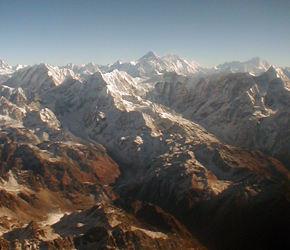 |
|
High atop the Tibetan plateau, a group of nomads was setting up camp. The ceaseless winds, usually sharp and chafing against the skin, were unusually calm and the sun warmed the men and women as they methodically worked. Once the tents were secured and the pack animals unloaded, the men set out to tend their herds. One young man stepped out of his tent to find his wife setting up her weaving loom. Her clothes bulged conspicuously over her stomach and she was having trouble reaching around to straighten the wooden poles. Her husband quickly ran over to help her and expressed his concern, but she smiled his worries away. Placing his hand over their unborn child and indicating the half-finished work on the loom, she simply said, "Mi chig la den chig." A rug for every person.
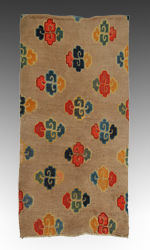 |
|
This saying reflects the prominence of rugs in traditional Tibetan culture. In fact, rugs are so central in Tibetan culture, households would often have more rugs than people, which is understandable. The thick woolen textiles were crucial to survival in a country where the average elevation is 15,000 feet – nearly 3 miles above sea level – and the temperature is cool in summer and excruciatingly cold in winter! However, rugs were not solely for warmth and insulation. They also functioned as decorative items that evolved into a highly collectible art form – one that the West was largely oblivious to until the 20th century.
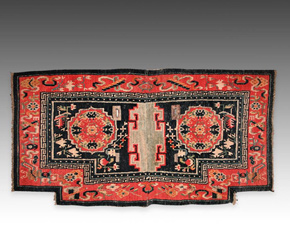 |
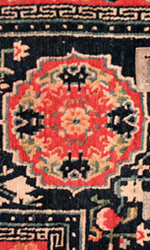 |
|
Tibet has always existed in geographic isolation, buffered by the Himalayas to the south; the Kuen Lun Range and Tsaidam Desert to the north; the deep river gorges of the Salween, Mekong and Tangtze rivers to the east; and the Karakoram Range to the west. In addition, the country existed in political seclusion to just about all but neighboring countries. As a result, the Tibetan people and their culture remained a mystery to most of the world. Yet, two major historical events ultimately opened up the country: first, in 1904, the British led a military expedition into the closed lands, forcing its way to the capital Lhasa; and second, in 1950 the Chinese invaded Tibet claiming the territory as part of their own country. These two events contributed most to the appearance of Tibetan art on the international market as many Tibetans were forced to sell household and ritual belongings to survive.
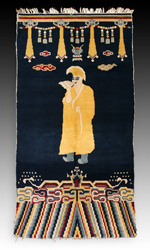 |
|
Authentic antique Tibetan rugs are difficult to come by simply because very few remain. The saying, a rug for every person is believed to also imply that the lifespan of a rug and its owner are roughly the same. As utilitarian items, rugs were used until they fell apart. The earliest examples of Tibetan rugs are dated to the 19th century, but the craft itself has existed for at least a millennium. As the weaving of rugs evolved in Tibet, a woven knot style unique to Tibet evolved. Rugs were utilized in all aspects of Tibetan life, ranging from religious to everyday functions, adorning monastery pillars and doorways as well as being used for floor coverings, wall hangings and saddle rugs for horses.
Despite Tibet’s relative isolation, it remained in contact with neighboring countries such as Nepal, Mongolia and China. When it comes to the art of rugs, the influence of these other cultures can clearly be seen, but none more so than China. In Tibetan rugs, one can often find Chinese motifs. For example, the 'shou' symbol, a round or rectangular monogram symbolizing 'long life,' can be found in many variations on Tibetan rug designs. The dragon and phoenix, emblems of power representing the complementary energies of yin and yang, also made frequent appearances as did stylized clouds.
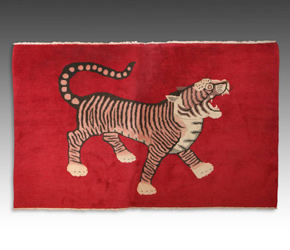 |
|
Despite symbols found in other cultures, the most significant source of design inspiration in Tibet was Buddhism. In fact, much of the indigenous art from the country related to Buddhist practice; however, this “religious” art almost always adhered to strict iconographic rules. Rug weaving was an exception as individual weavers exercised considerable artistic freedom in the creation of their textiles. Generally speaking, this distinction marks the difference between religious and folk art, and although it is unfair to characterize Tibetan rugs purely as folk art, it is very fair to say Tibetan carpets are diverse in terms of color, design and creative ingenuity. Try as you might, no two Tibetan rugs are identical.
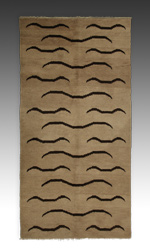 |
|
One particular style of rug was derived directly from Buddhist art and practice – the tiger rug. Though there is much speculation about the actual purpose of tiger rugs, it is easy to see their origin and how they were stylistically influenced. Tibetan thangkas (paintings directly related to the practice of Buddhism) and sculptures often featured wrathful deities wearing tiger pelts or sitting astride tigers. In the past, people of authority and power, such as chiefs, ministers and nobles, sat on real tiger pelts to emphasize their status. In addition, Buddhist art also would depict high lamas meditating on tiger skins imported from India, thus symbolizing humankind’s power to control the wild impulses of the ego. Gradually, woven rugs replaced actual skins, leading to the idea that these rugs actually served as meditative platforms as opposed to decorative floor coverings. As a result, the collecting community attributed great value and prestige – one might even say, enhanced collectability – to tiger rugs.
There are multiple styles of tiger rugs including those illustrating the tiger on the prowl, those in the form of a pelt, and those depicting only stylized tiger stripe patterns. One would think there is a limit to the variation weavers can make from the patterns of a tiger's fur; yet, tigers stripes are unique like fingerprints and rugs woven completely by hand reflect almost unlimited diversity in how these stripes are illustrated.
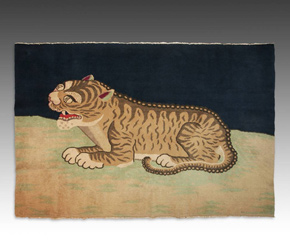 |
|
Just as Tibetan art was influenced by surrounding countries; tiger rugs had a reciprocal effect. In recent years the weaving of tiger rugs has emerged throughout Nepal and Mongolia. Scholars often describe these as 'happy tigers' for their almost cartoonish and jovial styles. Mongolian tiger rugs often exhibit a graceful compilation of various cultures and frequently incorporate simplified Chinese motifs. In Nepal, the wool is often mixed with silk and has evolved into a commercial product, yet this does not mean it is not collectible. These artworks reflect traditions that are hundreds of years old. Much like contemporary art referencing Chinese archaic forms, Tibetan, Mongolian and Nepalese pile rugs represent an art form honoring the continuity of revered ancient customs.
Some specialized rug weavers mastered the craft through apprenticeships and extensive training, but the majority of pile carpets were made by women of every class – from nobles' daughters to nomadic mothers-to-be. More than anything else, the lack of strict regulations allowed this art form to flourish. Tibetan rugs were made for the people and by the people with great care. They reflect the simple desire of Tibetans to decorate their lives with aesthetically pleasing and meaningful artworks; and this desire is no different than what motivates modern collectors.
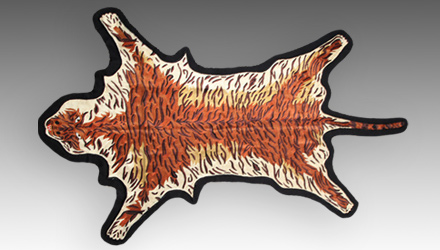 |
Download this Article: A Rug for Every Person – Tibetan Pile Carpets.pdf